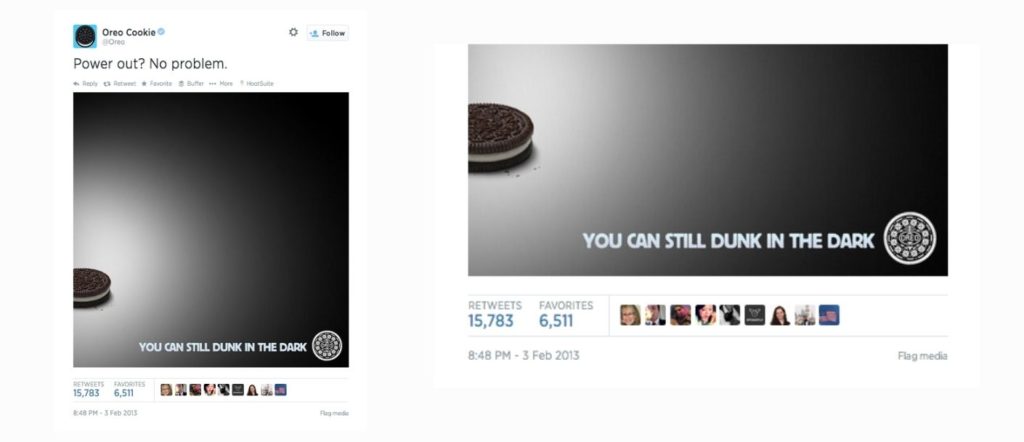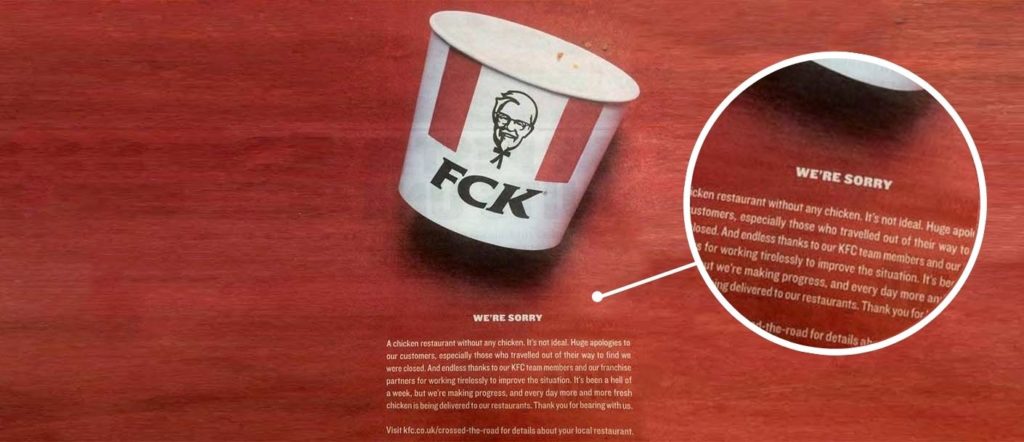Real-time marketing may get your brand attention in industry publications.
It may even help you win awards—but does it actually win you customers?
That’s the question we’re going to answer in this blog post. Let’s take a look at the state of real-time marketing in 2022 and see whether it’s still valuable for B2B brands.
What is real-time marketing?
Real-time marketing is when a brand responds in real-time to an event, a customer, a crisis, etc. The response is public, usually on social media, and is designed to get the brand a lot of attention very quickly.
Some of the best examples of this approach are passed around the marketing industry like myths or legends.
Oreo’s “Dunk in the Dark” tweet from the Super Bowl

KFC’s “FCK” apology for running out of chicken

IKEA’s response to the release of a look-alike Balenciaga bag

They’re brilliant, they’re fun, they’re famous, and they serve as examples of massive, instant publicity that every brand aspires to achieve.
But here’s the problem with real-time marketing that gets overlooked: it’s only relevant for a very short period of time. When you’re talking about divvying up your department’s budget, does it make sense to devote any sizeable percentage to this type of marketing?
After all, think of the most effective pieces of content your brand has created.
The blog that’s continuing to pull in traffic five years after you wrote it, the ebook that continues to get downloads, the video that has the most lifetime views on your YouTube channel—this content, we’re willing to bet, is evergreen. You planned it out, executed, and ensured that it would be relevant to your customers for months or years—not a few hours.
In fact, if you ask the people at the LinkedIn Marketing Solutions B2B Institute, real-time marketing is a flat-out terrible idea because of this inherently short-lived quality. As they explain in their “Contrarian Ideas in B2B Marketing” series, it’s nearly impossible to scale, and its effectiveness lasts a few hours at most.
Here’s what they have to say about the “Dunk in the Dark” tweet:
“The problem is very few people actually saw that original tweet, as it happened in real-time. At the time of the tweet, Oreo only had 60,000 followers, and you had to click a link to see the actual “Dunk In The Dark” image. Meanwhile, do you know how many Americans buy Oreos every single year? Around 20,000,000. Dunk in the dark indeed…
The Oreo tweet only became famous because trade journals like AdWeek celebrated it. How many of the mentions and retweets that followed were by marketing insiders, and how many were by regular consumers and true Oreos fans?”
Fair enough.
Here’s our take: Real-time marketing is a highly limited approach to raising brand awareness. It doesn’t reap great results in terms of getting more customers or sales either, but even still—we think it has its time and place.
If you think of real-time marketing as an element of your overall branding efforts, you can implement it sparingly and where it matters most—to help you establish your brand and amplify your more targeted long-term online marketing strategies.
Here’s what that could look like.
Real-time marketing as part of branding
Investing heavily in branding is critical if you want your business to grow sustainably. That means building and maintaining a strong brand voice, generating lots of valuable content, developing and implementing a cohesive design, and engaging in earned media (PR) campaigns on an ongoing basis.
Real-time marketing is part of establishing your brand voice. Your brand voice covers everything from how you talk to customers to how you present yourself on your website to what you say on social—including how you react to what’s going on in the world and in your industry.
For example, JetBlue threw a welcome party for a customer returning home to Boston after she tweeted a simple “thanks for the flight” message to their account. After a few tweet exchanges, she told them she expected a party—and to her surprise, JetBlue employees were actually waiting for her at her return gate with “Welcome Home” signs just for her.
That was a real-time marketing win, sure. But more than that, it was a concrete demonstration of JetBlue’s overall brand voice. It was fun, unexpected, and quirky, just like the company itself.
How should you balance real-time marketing and long-term, evergreen marketing?
Real-time marketing has its benefits. It shows that you are present, active, responsive, and ready to partake in the conversation. And, to be honest, in today’s marketplace, present, active and responsive are a necessity. Now, that doesn’t necessarily mean you will set up a large-scale real-time digital marketing campaign, but it could mean responding to social comments as soon as they pop up on your post, or participating in commentary on industry or world events as they unfold.
The thing to remember is that real-time marketing in itself is likely not going to win you new customers or earn you more sales.
What will?
Creating evergreen, highly valuable content. Securing earned media placements that boost your reputation and help earn customers’ trust. Increasing your share of voice. Anticipating your customers’ needs and questions, and creating content that answers those questions and fulfills those needs.
These are all branding efforts, and when used together, they can get you the really big wins—the sales, growth, and share of voice—that real-time marketing can’t.
If you’d like to see how our team can help your branding efforts, give us a call.




